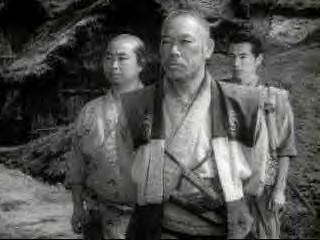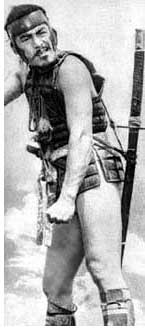The Seven Samurai
Some comments from Stephen Prince, The Warrior's Camera,
What is always impressive about Seven Samurai is its boundless
energy, the speed of its tracking shots, the aggressiveness of its wipe-linked
transitions, and the dazzling use of multicamera perspectives. The film
is an exercise in kinesis, in the realization of a cinema defined as pure
motion.(204)
Relations among the classes and the permeability of class
lines are central to Seven Samurai. (206)
. . .Seven Samurai is a reversal and a refutation
of the example of Ikiru, arguing against the possibility of solitary,
existential heroics. There is simply no space in this film where a hero
can stand as an individual. That space is constantly being transformed
into social terms where isolation and individualism are regarded as pathologies.
. .Kambei tells the others that everyone must work together as a group,
and that those who think only of themselves will destroy themselves and
all others. Kambei's words are extraordinary, given the ethical context
established by Kurosawa's contemporary-life films, where the hero is expected,
as a matter of course, to define an individual path. But here the material
of the past discloses no spaces in which the individual can move, no spaces
not already inhabited by groups and their demands. The self must be
an interactionist self or cease to exist. (210, italics mine)
Seven Samurai is a film about the primacy of groups,
the untranscendability of class, and by implication the fiction of individual
heroics.(212)
Yoshimoto has a slightly different take. He reminds us that within the group, each individual samurai is capable of individual, heroic action. Each one has their distinct personality which goes beyond being just a character type. "As individuated as they are," he writes, "the samurai and the village leaders are not completely autonomous individuals. They belong to differt groups and communities but decide to form a temporary alliance to fight against the bandits." (241) This idea was the seed that frew Kurosawa in to the plot of Seven Samurai and came to his attention as the result of research into the past when he discovered that such alliances were sometimes made in the fluid warring states era. Samurai sometimes protected villagers in exchange for meals. Using this plot idea, Kurosawa went about transforming the traditional jidaigeki which had been very stylized and formulaic, pulling elements from kabuki. Perhapos what drove Kurosawa was achieving realism in his portrayals. Not that Seven Samurai his meticulously historicall accurate, but it felt like it was. History as it might have been. Yoshimoto quotes Kurosawa: "An action film is often an action film only for the sake of action. But what a wonderful thing if one can construct a grand action film without sacrificing the portray of humans. This has been my dream since the time I was an assitant director. For the last ten years I have also been wanting to reexamine jidaigeki from a completely new angle. Seven Samurai has started with these two ambitions of mine." (240)
As one reviewer, Tom Bock puts it, when you conisder that movies these days are all about promising us summer blockbuster hits that provide "nothing more than those disposable responses known as 'thrills', it’s worth remembering that Akira Kurosawa once captured the convulsive feeling of being alive and crammed it inside of a movie." Isn't it what he does with his mulstiple cameras, his cuts, slow motion, his use of the telephoto lens, the way weather plays a role--all of combine to make it real and to make us feel that we are there, part of this epic struggle. Jidaigeki films, before Kurosawa, were very conventional; Kurosawa blew the doors off those convenstions and created a film with real characters, real people, inovlved in a real life struggle.
Characters:
1. Shimada KAMBEI (ShimuraTakashi), the "lead" samurai
When the villagers who live outside the boundaries of the village, by a mill, want to go it alone, Kambei fumes. "We can't risk 20 [houses] to save three. And if this village is destroyed, those three cannot survive on their own. That is the nature of war. By protecting others, you save yourself. If you only think of yourself, you'll only destory yourself. Such selfishness will not be tolerated. You're all in one boat."
"In war, it's teamwork that counts." Perhaps, not only in war, but in the project of rehabilitating and rebuilding Japan after the war, as well.
Perhaps, not only in war, but in the project of rehabilitating and rebuilding Japan after the war, as well.
2. KIKUCHIYO (Mifune Toshiro), the buffoon, the man who would be a samurai.

He is the first to admit the faults of the peasants--they are
crafty and dishonest. But who made them that way that they are? he challenges
the rest of the samurai.
3. Okamoto KATSUSHIRO (Kimura Ko), the young, idealistic samurai, whose story
is a coming of age story.

4. Katayama GOROBEI (Inaba Yoshio) the first to join Kambei and Katushiro
"My name sounds strong but. . ."
5. Hayashida HEIHACHI (Chiaki Minoru) of the "Woodcutter or 'Wood Chop' School of Swordsmanship"
Comparing cutting down enemies in battle to chopping wood he says, "There's no cutting me off when I start cutting, so I make it a point to run away first!" 
6. SHICHIROJI (Kato Daisuke), Kambei's right hand man; he actually refers to him as his "furui nyobo" or his "old wife," meaning someone who looks out for him like a major domo and keeps him on track. A chief of staff.
He answers YES to the proposition which will being no profit, no honor, without
hesitation.
"We might die this time," says Kambei.
He just smiles; his eyes shine. He is ready. 
7. KYUZO (Miyaguchi Seiji), the master swordsman
"A man only interested in perfecting his own skill"
SPOILER ALERT: Who dies FIRST AND when?
1. Heihachi was the first to die, shot during the raid on the bandits lair
when Rikichi ran to his (crazed) wife.
2. Gorobei was the second to die.
3. Kyuzo was the third, and
4. Kikuchiyo the fourth, and final of the seven to fall.
All were killed by bullets.
Kambei, and his old friend Shichiroji survive, hence his classic line "Mata
iki-nokotta na," or, "So, once again we have survived." But
Kambei understands that--as he has fought in losing battles all is life--"Kondo
mo makechatta na," or "We have lost again. It is the farmers who
have won" ["Katta no wa ano hyakushotachi da"].
Of course, Katsushiro survives, too. Wouldn't be much of a coming of age story,
if he didn't.
In the John Sturges western adaptation, The Magnificent Seven, there
is a character who was like an amalgam of both Kikuchiyo and Katsushiro--played
by Horst Buckholtz, a German actor--who was originally from a village, too, but is trying to
escape that heritage by becoming a big time gunfighter. At the end of the film,
though, he elects to stay in the Mexican village and work the land alongside the young
peasant girl, his love interest.
Katsushiro, however, could not do this. He is a samurai and cannot/will not
remain in a village as a peasant. No way. The class barriers are too high to leap over.
 Perhaps, not only in war, but in the project of rehabilitating and rebuilding Japan after the war, as well.
Perhaps, not only in war, but in the project of rehabilitating and rebuilding Japan after the war, as well. Perhaps, not only in war, but in the project of rehabilitating and rebuilding Japan after the war, as well.
Perhaps, not only in war, but in the project of rehabilitating and rebuilding Japan after the war, as well.




